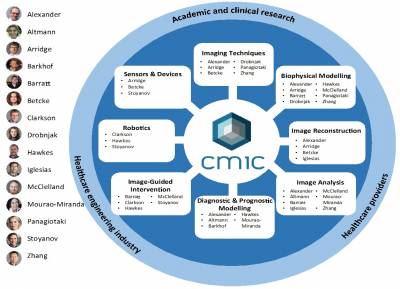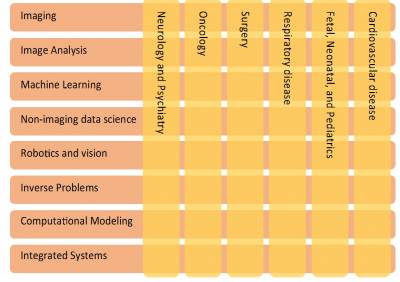We develop methods, primarily for healthcare applications, with a focus on imaging technology.
We combine research expertise and experience from mathematical and computational sciences and medical physics, and have strong collaborations with clinical and biomedical scientists. Specifically, we have expertise in image acquisition reconstruction and analysis, pattern recognition and machine learning, computational modelling, and computer-assisted interventional systems; key application areas are cancer, neurology, surgery and paediatrics.

Key topics of current interest within CMIC:
Novel imaging techniques include the emerging MRI paradigm of microstructure imaging (e.g. NODDI, SMT, and VERDICT and optical imaging techniques (optical tomography, Cherenkov light imaging, photoacoustic imaging, dynamic CT).
Many of our imaging techniques use cutting-edge biophysical modelling to exploit knowledge of the application domain and we maintain various computational modelling tools such as Toast and Camino; such modelling techniques and tools also drive and support much of our work on image reconstruction and image analysis.
We have world-leading expertise in core medical image analysis operations, such as registration and segmentation, and we maintain a variety of widely used software tools implementing them; see for example NiftyWeb and DTITK .
We have pioneered tools for diagnostic and prognostic modelling, such as the event-based model and techniques for imaging genetics, which exploits image features our image analysis tools provide.
Our work on image-guided intervention provides software tools to support surgical procedures, for example in prostate, liver, the eyes, and in utero.
We also have a substantial activity in robotics with a view to automating or semi-automating those procedures by developing software tools for the Da Vinci system and miniaturised robots for eye surgery.
The design of robotic surgical systems often involves the development of novel sensors and devices, for example to mount on the end of a surgical probe.
In turn, new sensors require novel imaging techniques to reconstruct useful information from them, which brings us full circle in the diagram.

 Close
Close

